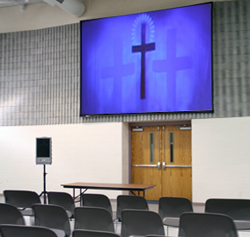
System characteristics that are important to a portable church:
1) It must be simple to set up.
Front of house, including mixer is all in one rack. The amps are either in the same rack or a similar rack onstage. Racks have a single AC cord with power distribution in the rack and a single “on” switch. Subwoofers are usually too complex, so 15-inch-loaded 2-way loudspeakers are on stands left and right of stage.
Cables are color-coded or numbered. Mic cables, instrument cables and direct boxes are all in the same storage container. In a larger portable system, multi-pin connectors become important to reduce the number of mic cables used.
2) It must be simple to operate.
Most churches, especially portable churches, have volunteers running sound. A 40-channel console with 4-band EQ and 8 aux sends may be more than a volunteer can handle. Startups, in particular, get by with two or three monitor sends and a 3-band EQ. A 16- or 24-channel console is likely to be plenty.
3) It must be articulate.
Congregation members won’t care if you can get 120 dB in the back of the room. Rather, can they understand the words clearly and without straining in every seat in the house? Loud is great, but only if it’s clear and clean. It’s more important to have 95 dB with crystal clarity than a subwoofer that kicks them in the chest.
4) It must be flexible.
In a typical service, the system needs to handle a live band, background music, and several people speaking to a crowd that may vary in size from week to week. The venue may also change at some point. And in warmer months, the church might take the system to the park for a concert.
5) It must be expandable.
Portable churches are usually growing churches. When the congregation of 75 becomes a congregation of 200, it requires more from the sound system. An upgrade path is needed. Leave room in the amp rack for another amplifier to run more loudspeakers. Begin with a mixer that has at least five or six channels more than needed, so as the band membership grows, the system still works. This is a good time to apply the maxim “buy your second one first.”
6) It must be affordable, but not cheap.
Built from scratch, a good beginning system will probably cost several thousand dollars. Too often, portable churches begin with an inadequate system, and replace it with a second system a year or two later.
This is not a place for the latest, state-of-the-art accessories. Digital consoles might not fit the budget. Effect processors and many compressors are luxuries. Simple microphones, consoles, EQs, amplifiers and loudspeakers (or self-powered loudspeakers) are sufficient. Caution: do not get the wrong gear just because it’s “on sale.”
7) It must be reliable.
Saving a few dollars on an amplifier is not as important as choosing gear that is known to be reliable. Your brother-in-law may have donated an old no-name power amplifier from his basement (a syndrome known as “give your junk to Jesus”), but a new Crown or QSC amplifier for the main loudspeakers will prevent problems. Maybe that no-name amp can be sold to a struggling high school band with the money used to buy a good equalizer.
Keep in mind that volunteers will be loading and unloading this system every week, probably for several years. It had better be rugged enough not to need maintenance every month.
8) It must be supported.
Because most portable churches don’t have a full-time or even part-time technical staff, they need to have a resource person they can trust. This needs to be someone who knows their situation, knows their system, and has experience with what they’re doing. Most importantly, this person must be able to speak in layman’s terms to translate technical issues into common English.
David McLain is a church sound system consultant with CCI Solutions, and has been working with church sound systems since 1978 and with portable churches since 1988. He also runs the Church Sound Guy blog.
